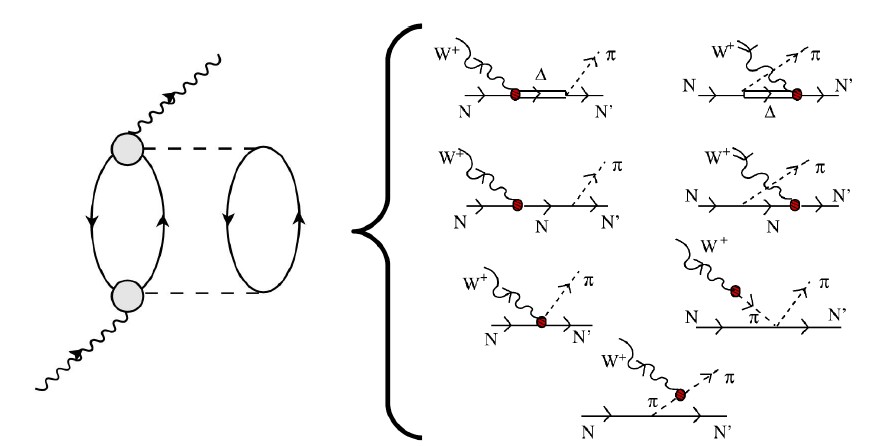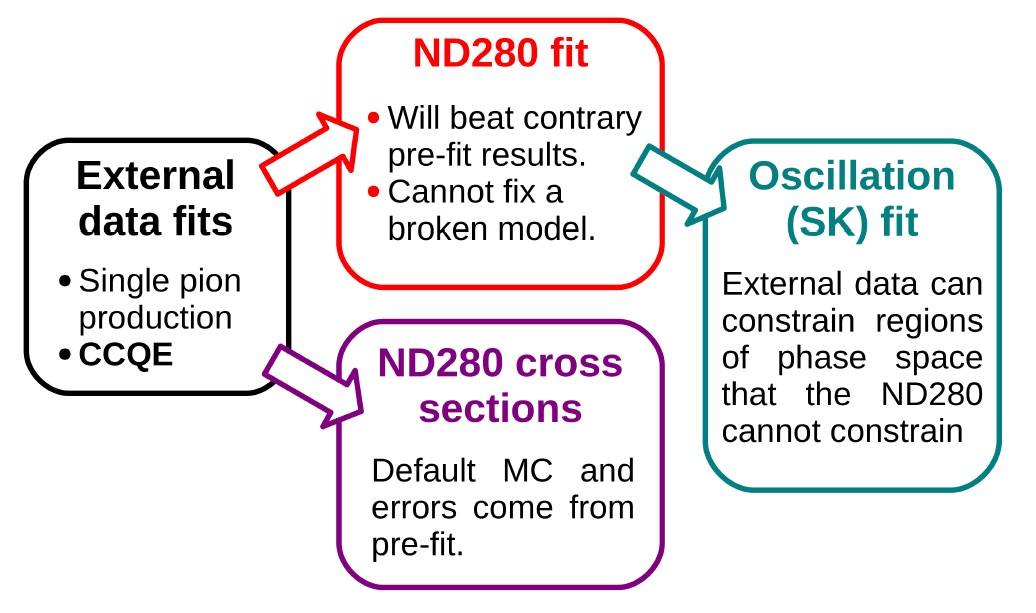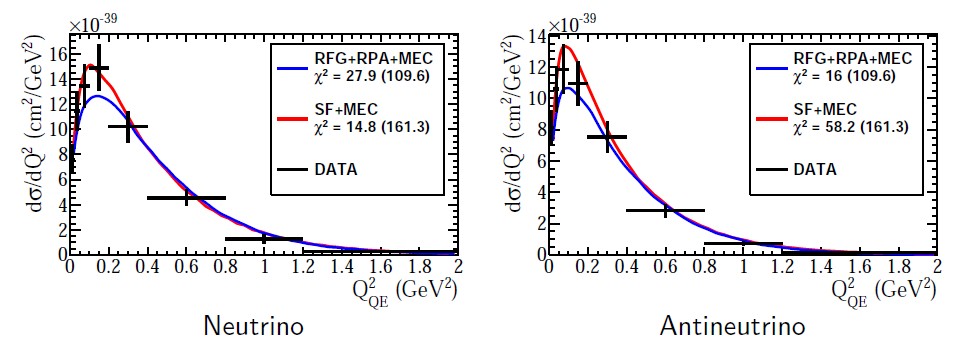Neutrino-nucleus interactions
(Callum Wilkinson, Patrick Stowell, Susan Cartwright)

The interaction of a relatively low-energy neutrino with a nucleus is not a simple matter of W exchange between a neutrino and a quark. As well as the momentum distribution of nucleons within the nucleus and quarks within the nucleon – significant when the energy of your neutrino is typically < 1 GeV, as in T2K – there are also multi-nucleon effects to contend with. The figure shows Feynman graphs from the Nieves et al. model of multi-nucleon interactions (known as MEC or "meson exchange currents").
As a result of such effects, and a lack of good experimental data, the models of neutrino-nucleus interactions used in simulations are not complete descriptions of the physics and frequently do not describe the data very well. This is a critical issue in oscillation analyses because it is necessary to unfold the measured charged lepton energy spectrum back into the neutrino energy spectrum: as multi-nucleon effects can affect the momentum of the outgoing charged lepton, a poor understanding of such effects results in large systematic errors.
The T2K analysis strategy, shown in the flow diagram below, uses both pre-fits to external data and fits to ND280 data to constrain the model for the oscillation fits.

|
| T2K analysis strategy. Fits to external (MINERνA and MiniBooNE) data are used to set the initial model parameters, which are then used for ND280 cross-section measurements and as input to ND280 parameter fits used to constrain the Super-K oscillation analyses. |
Optimising the physics input to the T2K simulation is the job of the Neutrino Interactions Working Group (NIWG). Callum Wilkinson is a prominent member of the NIWG and is responsible for comparing different models for charged-current quasi-elastic scattering (CCQE, νμ n → μ– p) to external datasets.

|
| Model fits to MINERνA data, part of a combined fit to MINERνA and MiniBooNE. Although the MiniBooNE and MINERνA data are in tension with each other, the model combining relativistic Fermi gas (RFG) with random phase approximation (RPA) and meson exchange currents (MEC) fits the data better than the spectral function (SF) + MEC model (note that RPA cannot currently be implemented in SF models). |
A major problem in this analysis is that the external datasets do not agree with one another, so that the combined fit is a balancing act between two somewhat incompatible inputs. Furthermore, the MiniBooNE data have many more points than the MINERνA data and are not supplied with a full correlation matrix, therefore increasing the risk that the overall fit does not properly take account of both datasets. To handle this, Callum introduced the parameter goodness-of-fit test, widely used in the sterile neutrino community, which is designed to handle joint fits to statistically independent datasets.
This work will form the basis of Callum's PhD thesis and has been written up in several T2K technical notes.
Cross-section modelling and sterile neutrino searches
(Callum Wilkinson, Patrick Stowell)
Sterile neutrinos are hypothetical additional neutrino flavours which do not couple to the W and Z, but may be included in neutrino oscillations. Although very heavy right-handed (thus sterile) neutrinos are expected in Majorana models of the neutrino, where they can explain the lightness of the active neutrinos via the seesaw mechanism, the term "sterile neutrino" in the context of oscillations usually refers to much lighter objects, with masses on the eV scale, which have been invoked to "explain" discrepancies such as the LSND and MiniBooNE anomalies and the disagreement of reactor neutrino experiments with the most recent calculated fluxes.
As sterile neutrinos by definition do not undergo CC interactions, evidence for oscillation into sterile states must be sought in disappearance experiments, ideally NC disappearance experiments so that oscillations between active flavours (i.e. the three standard model neutrinos) do not contribute. In the context of the cross-section uncertainties discussed above, however, this introduces a problem: is a disagreement between NC data and expectation to be ascribed to oscillation into a sterile state, or simply inadequate understanding of the relevant cross-section?
Callum Wilkinson has investigated this in the context of MiniBooNE NC elastic scattering data[1], finding that it is necessary to fit both the cross-section model parameters and the sterile neutrino contribution simultaneously in order to obtain a statistically robust result. More recently, in his final year project supervised by Callum, Patrick Stowell showed that varying the cross-section model implemented in the simulation had significant effects on sterile neutrino limits using MINERνA data. This result is also being prepared for publication.
Publications
- Callum Wilkinson, Susan Cartwright and Lee Thompson, JHEP 2014:64 (link to article).

